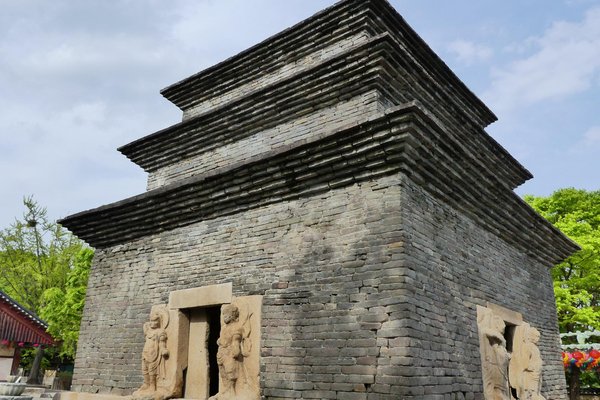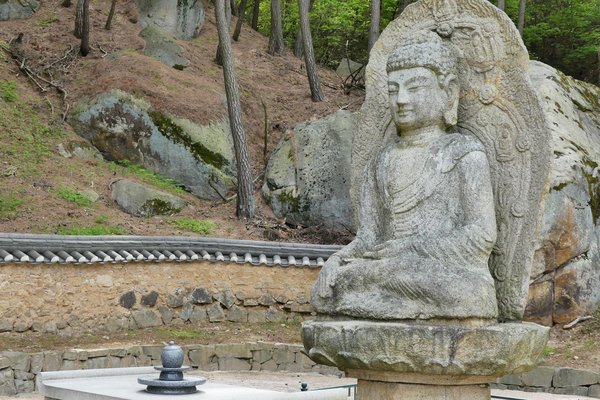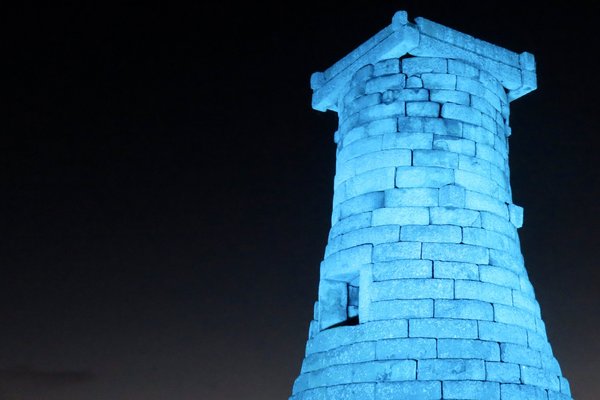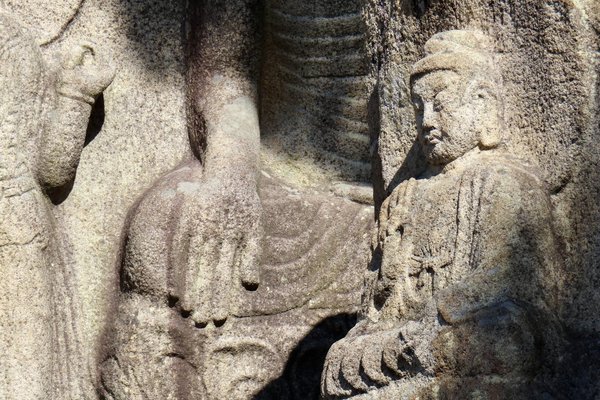Republic of Korea
Gyeongju
Gyeongju Historic Areas, comprising the former capital of the Silla Kingdom, is a repository of ancient Buddhist and secular treasures.
Numerous statues, reliefs, pagodas, the remains of temples and palaces, royal tombs and even an ancient astronomical observatory have been preserved in and around Gyeongju. They date from the Kingdom’s flowering period of the 7th - 10th centuries.
Community Perspective: Most find the sights overrated, except for the cute Cheomsongdae Observatory. Clyde has visited all (sub)locations and GabLabCebu highlights Mt. Namsan.
Site Info
Official Information
- Full Name
- Gyeongju Historic Areas (ID: 976)
- Country
- Republic of Korea
- Status
-
Inscribed 2000
Site history
History of Gyeongju
- 2000: Inscribed
- Inscribed
- Type
- Cultural
- Criteria
- ii
- iii
Links
- UNESCO
- whc.unesco.org
- Official
-
- gyeongju.go.kr — Gyeongju World Heritage
- Related
-
- lifeinkorea.com — Link
- gyeongju.museum.go.kr — Link
All Links
UNESCO.org
- whc.unesco.org — whc.unesco.org/
Official Website
- gyeongju.go.kr — Gyeongju World Heritage
Related Resources
- lifeinkorea.com — Link
- gyeongju.museum.go.kr — Link
News Article
- May 29, 2020 en.yna.co.kr — Late 5th-early 6th century funeral relics unearthed at royal tomb complex
Community Information
- Community Category
- Archaeological site: Far Eastern
Travel Information
Gyeongju hotspot
Recent Connections
-
Global Geoparks
Gyeongbuk Donghaean UNESCO Global Geopa…
-
Grave Looting
The tombs in Gyeongju were extensively …
-
Geomancy
Gyeongju, as the capital of the Silla K…
Connections of Gyeongju
- Individual People
-
-
Homer B. Hulbert
"Near this ancient town we find a numerous cluster of huge mounds, each the maosoleum of King of Silla. Another relic of that civilization is an ancient stone tower some twenty feet high, shaped like a monster bottle. This was the astronomical observatory of ancient Silla." - The Passing of Korea (1905) pg 290-291 -
Travels of Hyecho
"Hyecho was born in Gyeongju, the capital of the Shilla Dynasty, in 704. At age 15, he went to China to study esoteric Buddhism in 719 and after turning 19, he set out for India for further study of Buddhism in 723." - english.donga.com
-
- Trivia
-
-
Dragon
Hwangnyongsa Temple (Temple of Imperial Dragon) -
On Banknotes
Cheomseongdae - astronomical observatory in Gyeongju; 10 Korean Won; Issued 1962-1969 South Korea 10 Won 1965 -
On Passports
('The Heavenly Horse' painting found within the chamber of Cheonmachong) pages 6-7 -
Former Largest Cities
During the Unified Silla period (618AD to 918AD), Gyeonju's peak population likely reached 1,000,000 inhabitants (wiki)
-
- History
-
-
Three Kingdoms of Korea
-
Historical Food Remains
Excert from National Geographic Magazine (August 1988) Kyongju, Where Korea Began by Cathy Newman (Concerning the Heavenly Horse Tomb) "We also found eggs in the coffin." "Eggs?" "Seven Eggs. One or two actually intact. To nourish the dead." -
Famous suicides
"When Gyeon Hwon's army sacked Gyeongju in 927, they found Gyeongae partying at the Poseokjeong pavilion. The king killed himself rather than surrender. Gyeon Hwon set Gyeongsun on the throne in his stead, and returned to the west." - wiki -
Buried treasures
Silla Treasures excavated in the "Gold Crown Tomb" (Geumgwanchong), in 1921. The tomb was the first to bear one of the sumptuous gold crowns of the Silla royalty. 40,000 artifacts were recovered from the tomb, including gold, silver, and bronze vessels. Also included were gold and silver weapons. Now primarily in the Gyeongju National Museum. - wiki -
Located in a Former Capital
Silla Kingdom -
Silk Roads
Eastern Route; The Silk Road contributed to the Golden Age of Silla. Silla Kings allied with the Tang dynasty to defeat rival Korean kingdoms. The flowering of Buddhism in Gyeongju in the 7th and 8th centuries began with the Silk Road extending to the Korean peninsula.See en.unesco.org
-
Queens and Empresses
Queen Seondeok (606 - 647) built the Star-Gazing Tower or Cheomseongdae -
Mongol Invasions
"Hwangnyongsa - This group consists of two ruined temples, Hwangnyongsa and Punhwangsa. Hwangnyongsa, built to the order of King Chinhung (540-76) was the largest temple ever built in Korea, covering some 72,500m2. An 80m high nine-storey pagoda was added in 645. The entire complex was destroyed by Mongol invaders in 1238." - AB Document -
Birthplaces
"Crit vi. Mount Namsan is a sacred site containing the birthplace of Hyokkose, the founder of the Shilla Kingdom"See en.wikipedia.org
-
- Architecture
-
-
Stand-alone Rock Reliefs
11 Buddhist rock-cut reliefs; the most impressive is probably the Buddha Rock, a massive natural formation in the T’apkol Valley. (AB ev) -
Geomancy
Gyeongju, as the capital of the Silla Kingdom (and later Unified Silla), adopted the Tang Dynasty's urban planning model, which is the very same source for the Jōbō system used in Nara (Heijō-kyō) and Kyoto (Heian-kyō)
-
Rock Cut Architecture
Mount Namsan "The rock-cut reliefs and engravings and the stone images are fine examples of Shilla Kingdom Buddhist art from the 7th to the 14th century. They are artistic masterpieces which trace the evolution of this especially refined school of Buddhist art throughout its most prolific and innovatory period, in particular from the 7th to the 10th century. They depict for the most part Buddha, and also the saints and bodhisattvas associated with him. Skilful use is made of the landscape in siting many of the sculptural groups. The most impressive is probably the Buddha Rock, a massive natural formation in the Tapkol Valley. It is located close to a three storey pagoda, and its three walls are decorated with vivid depictions in bas-relief of Buddha in different incarnations, surrounded by his acolytes and disciples." - Advisory Body Evaluation (2000) -
Earth Architecture
Wolseong Fortress "The fortress was built in 101 AD. The east, west, and north walls were built on stone/earth foundation covered with clay. -Kyongju by Kim, Yong-nam (published by Woojin Press, Seoul, Korea) 2008 -
Brick architecture
Bunhwangsa Temple was built in honor of Queen Seondeok (27th ruler of Silla, 632-647), who was the first female ruler of the Silla kingdom. Here you will find Mojeonseoktap, the oldest surviving stone pagoda from the Silla kingdom. A structure unlike any other, Mojeonseoktap is made of roughly-hewn stone bricks.
-
- Damaged
-
-
Grave Looting
The tombs in Gyeongju were extensively looted and excavated during the Japanese occupation of Korea (1910–1945). This period saw a mix of state-sponsored archaeological "investigations" and rampant illegal plundering by private collectors and antique dealers. Some were returned to Korea after 1965, but thousands of artifacts in Japanese museums or private collections are believed to have originated from Gyeongju's tombs, but because they were removed without proper documentation during the occupation, proving their "stolen" status is often legally difficult.
-
Destroyed during invasion
"Hwangnyongsa - This group consists of two ruined temples, Hwangnyongsa and Punhwangsa. Hwangnyongsa, built to the order of King Chinhung (540-76) was the largest temple ever built in Korea, covering some 72,500m2. An 80m high nine-storey pagoda was added in 645. The entire complex was destroyed by Mongol invaders in 1238." - AB Document
-
- World Heritage Process
-
-
Perfect Inscriptions
2000
-
- Religion and Belief
-
-
Legends and Folk Myths
The legend of Silla's founding. "According to the Samguk Sagi, a 12th-century Korean history, Sirim was the site where the child Kim Alji, founder of the Gyeongju Kim clan, was discovered. Found in a golden box accompanied by a rooster, he was adopted by the royal family. His descendants became the later kings of Silla and the forest where he was found was renamed Gyerim, "rooster forest." - wiki -
Pagoda
Bunhwangsa Pagoda (stone-brick) -
Sacred Mountains
"Mount Namsan, which had been venerated by the existing cults of Korea, became a Buddhist sacred mountain and attracted its adherents, who employed the most outstanding architects and craftsmen of the day to create temples, shrines, and monasteries." - AB Document -
Taoism
Anapji Pond - "The name Anapji appears in the 16th century Joseon era document Augmented Survey of the Geography of Korea with the explanation that King Munmu made the pond with Taoist aesthetics." - wiki -
Buddhist Pure Land
"With the spread of Buddhism Mt. Namsan became the earthly representation of Sumeru, the heavenly mountain of the Buddhist lands." - AB Document
-
- Human Activity
-
-
Piracy
"Wokou (Korean pronunciation: waegu), which literally translates as "Japanese pirates" in English, were pirates of varying origins who raided the coastlines of China and Korea from the 13th century onwards. The term Wokou was used by both Chinese and Korean troops in reference to the invasion force of Toyotomi Hideyoshi." - wiki The Imjin War was an Invasion force meant to conquer Korea, China, and India. This could hardly be classified as "piracy". However, Wokou did make up a large portion of the Japanese navy. Furthermore, there is one infamous example of piracy on the Japanese retreat back to the sea which sole purpose was revenge and plunder. "With Kato Kiyomasa's last withdrawal vengeance was wreaked, and the entire city (Gyeonju) was put to the torch, including the wonderful Bulguksa temple. Loaded with plunder, Kato reached the sea coast of Ulsan." -
Crown Jewels
"The Silla crowns are some of the most spectacular treasures uncovered in the tumuli of Gyeongju. The best of the crowns are made of pure gold and were probably reserved for kings. The use of many tiny gold mirrors dangling from the crown has led some to hypothesize that the crown, worn in sunlight, would be a dazzling spectacle reinforcing the tradition role of the Silla king as the symbolic representation of the sun on earth." - wiki -
Slavery
"Records from the Kingdom of Silla, show some cases of large slaveholding and even the custom of burying slaves alive for the king's funeral." - The Historical encyclopedia of world slavery, Volume 1; Volume 7 By Junius P. Rodriguez -
Festivals
Silla Cultural Festival - Events: National Classical Music concert at the Anapji Pond. The serene Kyerim Glade is the setting for a poem composition contest."Every year since 1962 a Silla Cultural Festival has been held in October to celebrate and honour the dynasty's history and culture. It is one of the major festivals of Korea. It features athletic events, folk games, music, dance, literary contests and Buddhist religious ceremonies." - wiki & eng.buddhapia.com -
Human Sacrifice
The Great Tomb of Hwangnam, "Excavations have found that a man was interred in the northern mound and a woman in the southern mound. The man's burial chamber contained remains of a yound woman believed to have been buried for her master. Hence the tomb is assumed to have been made before King Jijeong (reign 500-515) banned sacrificial burials." Unesco World Heritage of South Korea (2011, pg 88) -
Ongoing Archaeological digs
10-year time frame for archeological digs/exploration
-
- Constructions
-
-
Stelae
Gyerim Woods Stele memorializing the founding myth of Silla. "This legend is inscribed on a memorial stele erected in 1803, the 3rd year of King Sunjo of Chosun dynasty." - Nomination File -
Dynastic Burial Places
Tombs of ancient Silla dynasty -
Bixi
Many Bixi statues from various Silla Tombs, now mainly kept at Gyeongju National Museum -
Famous Bells
Emille Bell, one of largest bell made in Asia and it's said that its ringing can be heard over 3 Km radius when struck only lightly with the fist -
Tumuli
-
- WHS on Other Lists
-
-
Global Geoparks
Gyeongbuk Donghaean UNESCO Global Geopark
-
Cultural WHS set within an IUCN recognised protected area
Gyeongju National Park, IUCN category V (Protected Landscape/Seascape)
-
- Timeline
-
-
Built in the 7th century
The Gyeongju Historic Areas contain a remarkable concentration of outstanding examples of Korean Buddhist art, in the form of sculptures, reliefs, pagodas, and the remains of temples and palaces from the flowering, in particular between the 7th and 10th centuries, of this form of unique artistic expression. (There are sites in Gyeongju that are signifigantly older than the 7th century, however the vast majority of inscibed properties are during or after the 7th century, corresponding to the introduction of Buddhism)
-
- WHS Hotspots
-
-
Gyeongju hotspot
Located in the heart of Gyeongju
-
- Science and Technology
-
-
Astronomy and Astrology
Cheomseongdae observatory
-
- Literature & Film
-
-
History of the World in 100 objects
Prog 49 "Korean roof tile" (link)
-
News
- en.yna.co.kr 05/29/2020
- Late 5th-early 6th century funeral…
Recent Visitors
Visitors of Gyeongju
- AC
- Adrian Turtschi
- AK
- Alberto Rodriguez Gutierrez
- Alexander Lehmann
- Alexander Parsons
- Alex Goh
- AlexSchedel
- Ana Lozano
- anthonybonbon
- Artur Anuszewski
- Atila Ege
- AustralLights
- Badwater
- Bernard Joseph Esposo Guerrero
- Bigboss99
- Bill Maurmann
- bossc
- Bram de Bruin
- c82wc1
- Can SARICA
- Casey
- Chalamphol Therakul
- Chantal den Haan
- chenboada
- Cheryl
- Christravelblog
- Clyde
- Colossus
- Corinne Vail
- ctravel
- CugelVance
- cutecid
- cwthong
- Danieljbromberg
- Dennis Nicklaus
- Dimitar Krastev
- DouglasR
- Dr. Caligari
- DutchHorn
- Elaine McArdle
- eljx1988
- Els Slots
- Erik Jelinek
- Eva Kisgyorgy
- Fan Yibo
- Felicité
- Frederik Dawson
- GabLabCebu
- Garrett
- Gary Arndt
- GeorgeIng61
- Hadrianus
- Hammeel
- Harald T.
- Harry Mitsidis
- H Beswick
- Hdwilsonau
- henrik_hannfors
- henryjiao18
- Iain Jackson
- Ian Cade
- inomusay
- Jacob Choi
- Janos
- Jarek Pokrzywnicki
- Javier
- Jeanne OGrady
- Jeffrey Chai
- JL
- J_neveryes
- João Aender
- Joel on the Road
- Jonas Kremer
- Jon Eshuijs
- Jonoprout
- JoStof
- Joyce van Soest
- Kasper
- Ken DJ
- Kim, Soo-youn
- KngAlaric
- Kristin
- krtek
- Kyle Magnuson
- Lee Kai Loong
- Leonie Geurts
- Liamps91
- lichia
- Loic Pedras
- Luboang
- Ludvan
- Lukasz Palczewski
- Luke LOU
- Maciej Gil
- Martin
- MaYumin
- Michael Ayers
- Michael Novins
- Michael Turtle
- Miguel Marquez
- Mihai Dascalu
- Mikan22
- Miloš Tašković
- MMM
- Morodhi
- Mstrebl1990
- Nafis N
- Naim Y
- nan
- Niall Sclater
- Nihal Ege
- Nuria8
- Patrik
- Paul Schofield
- Pchxiao
- Peter Lööv
- Petteri
- Philipp Peterer
- phillipmeng
- Pradip Tripathy
- ReallyDeepThoughts
- Reza
- Rob Wilson
- Roman Bruehwiler
- Sclowitz
- Sergio Arjona
- Shandos Cleaver
- Shijie ZHU
- sibariam
- Simonf
- Simonh
- Slavi
- Solivagant
- Stanislaw Warwas
- Szucs Tamas
- Tammy Gouldstone
- Taotao Chen
- Tcchang0825
- Thomas Buechler
- Thomas van der Walt
- tony0001
- trish91198
- Vernon Prieto
- Vincent Cheung
- voyager
- Walter
- Westwards
- Xiong Wei
- Xiquinho Silva
- Zach
- Zoë Sheng
- Zos M
- ZZSong
Community Reviews
Show full reviews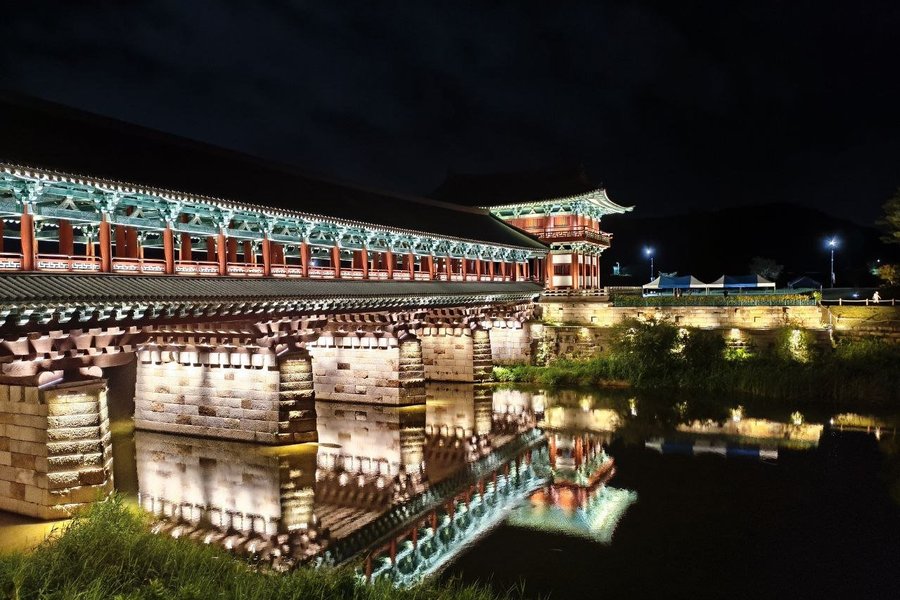
Time of the visit: 22-24th of sept.,2025 and again on the 20th of oct. having a day trip from Busan -where I stayed for 4 werks- to visit my last missing component in Gyeonju,the Namsan mountain.
The most impressive single element of all the World Heritage Sites (I'm still missing Namhansanseong at this point) in Korea is, in my opinion, the Tongdosa Temple, but Gyeongju has many different fascinating components that, as a whole, are unbeatable. Gyeongju is in my top third of all the World Heritage Sites I've visited.
The Gyeongju Historic Areas are a serial UNESCO World Heritage Site located in Gyeongju.. They include multiple zones featuring the remains of the Silla Kingdom (57 BCE–935 CE) — temples, palaces, pagodas, tombs and Buddhist sculptures — reflecting a rich fusion of religious, artistic and secular architecture. Specifically, they:*showcase outstanding examples of Korean Buddhist art (sculptures, reliefs, pagodas) from the 7th–10th centuriwwes.*bear testimony to the culture, religion and social structure of the Silla dynasty for nearly a thousand years.They are composed of five distinct belts or areas around Gyeongju, each with its own set of monuments and features.
1:Mount Namsan Belt((north of the city) – Ruins of 122 temples – 53 stone statues, 64 pagodas, in 16 stone lanterns – rock-cut reliefs/engraved stones, tomb groups, stone banner-poles – Fortress wall on Namsan, the site of the Poseokjeong Pavilion & Seochulji Pond
2:Wolseong Belt( Ruined palace site of Wolseong – Gyerim woodland – Anapji Pond – Observatory Cheomseongdae)
3:Tumuli Park …
Keep reading 2 comments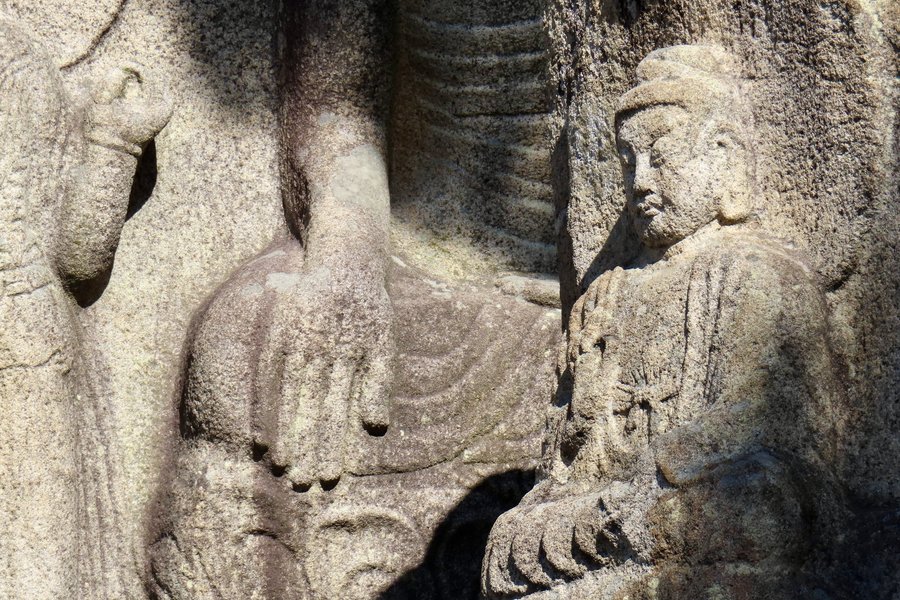
I first visited Gyeongju in early Spring 2008 and again that following Summer, those memories remain special. Yet, at the time I knew little about what sites in Gyeongju to prioritize. Returning in 2025 meant truly exploring and appreciating the icons of Gyeongju. I planned long in advance that an essential visit would be Chilburam in Namsan Mountain.
Chilburam (Namsan) - The fastest route to Chilburam is starting from the Three-story Stone Pagoda of Yeombulsa Temple Site, a local route that is not included in a lot of the brochures or promoted hiking routes for Namsan Mountain. It only takes 2-3 hours round-trip and that includes times for pictures and options to visit the Sinseonam Hermitage directly above Chilburam.
Tumuli - The variety of tumuli in around the Gyeongju city center is impressive, I enjoyed the view from the OAR Contemporary Art Museum.
Cheomseongdae - A delightful structure (night picture)
Bunhwangsa - Built only a little after the Baekje stone pagoda at Mireuksa, this is a particularly magnificent example of an ancient Silla Buddhist Temple.
Besides these treasures, Gyeongju is simply a fantastic place to walk in the mornings or evenings. I would like to return in the Fall, for both cooler temperatures and to hike more of Namsan Mountain. We met exceptionally kind people in Gyeongju, including locals who offered a ride so we did not have to wait for an infrequent bus.
Keep reading 3 comments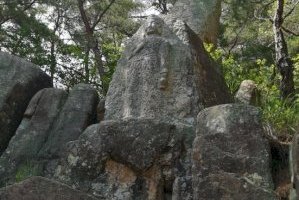
The Korean nation has been unified by just three powers in its history, the Silla in Gyeongju, the Koryeo in Kaesong, and the Joseon in Seoul. For that, these are probably the three most historically rich and significant cities on the peninsula. The Joseon cultural heritage is the basis for four different WHSs in Seoul (with a fifth one in nearby Suwon), but Gyeongju's Silla heritage has been somewhat strangely divided into two sites. Sure, I guess Bulguksa and Seokguram, being located a fair way away from the main city, in Tohamsan, do make a good single site together, but I personally feel like Gyeongju would be better off with either a single all-encompassing site to truly capture the greatness of the Silla capital or three or more to actually highlight the different aspects of its heritage; for example, I feel that the OUV of Namsan and Tohamsan are much more similar than between Namsan and the Tumuli fields. Actually, I see Namsan not as inferior to Tohamsan in granite carvings, but as a single world wonder of Silla stonework, with Seokguram as its crown jewel, but being just as worthy of its prestige regardless of it. Thus, a combined site of Gyeongju's Silla heritage would probably get a 4.5 from me. Nevertheless, I've found the main Gyeongju site to be well worth the journey, and despite the crowds and the underwhelming response you may have if you don't know what to expect and/or only stick to the central touristic …
Keep reading 0 comments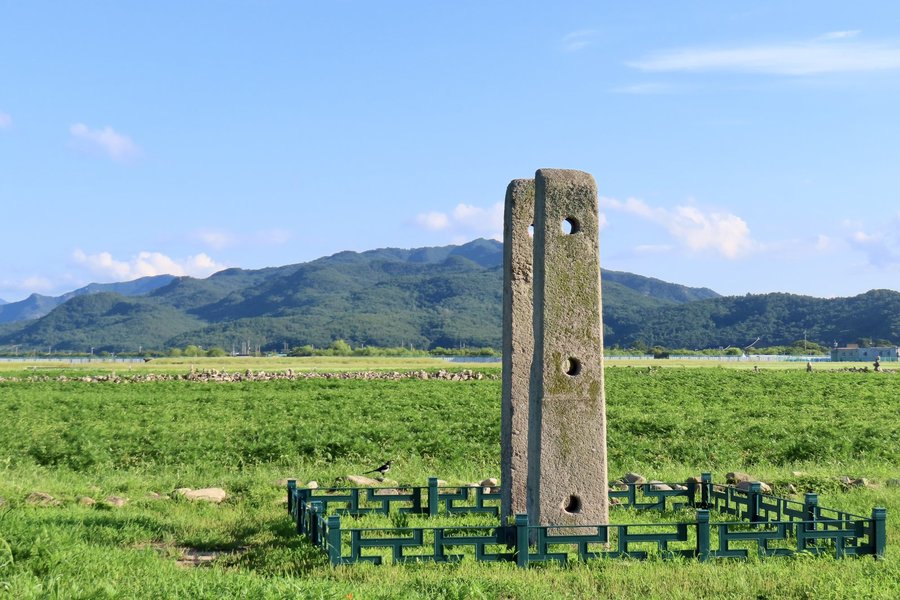
I have been to all but one of the UNESCO sites in South Korea. This is my favorite UNESCO site. And not just in Korea, but in the world.
Rome would be tied but Gyeongju represents (to me) what the World Heritage Site status should be doing - bringing incredible sites people otherwise wouldn't hear about into the foreground. Most people who do not live in Korea have never heard of it, and those who visit Korea typically stick to Seoul or Busan. Korea, perhaps surprisingly in an age with Korean music, food, cinema, and fashion sweeping the globe, doesn't advertise most of its amazing sites. The Jeju Lava Tubes are unlike anything I've seen before, and the dolmen sites at Gochang seem to go on forever.
Gyeongju is ripe for the kind of mystique and reverence we place on pyramids - not because they're as old or as complicated to build, but because there's something enchanting about it. Six kings and queens beneath massive mounds of slumbering earth, each with a towering crown of golden antlers. A treasure trove of beautiful artwork and wealth, items from around the world finding themselves here.
And yet the people of Gyeongju can sometimes live stunningly close to these ancient mounds. Enjoying daily life, having picnics. But the UNESCO site doesn't stop at the mounds. It includes the oldest observatory in the world, palaces, temples, monuments - all scattered throughout the countryside. There is still a ton of excavation going …
Keep reading 0 comments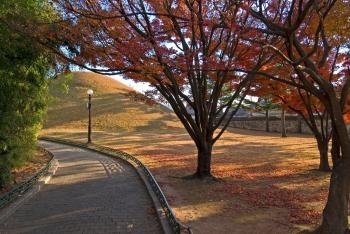
I visited here in the autumn of 2007.
I would describe Gyeongju as the Korean Equivalent of Kyoto or Nara, only not as well preserved. There are fewer historic structures and monuments standing compared to what you will find in Kyoto.
I stayed in Gyeongju for several days where I was able to spend time exploring this site as well as the nearby Seokguram Grotto and Bulguksa Temple.
I thought that Gyeongju was the best site I visited in South Korea.
Read more about Gyeongju Historic Area on my website.
Keep reading 0 comments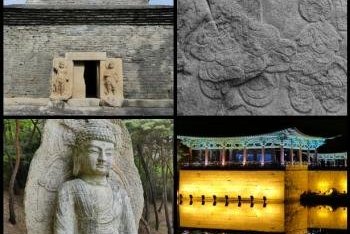
I visited this WHS in April 2017. I visited all the different locations spread out around Gyeongju over 2 half days which yielded no tangible appreciation from the sites themselves (apart from the oldest astronomical observatory). Each location of this WHS has a UNESCO stone marker. I'd recommend leaving some time for the impressive Silla collection at the National Museum of Gyeongju (free entrance).
However, I really wasn't that impressed by the ruins/sites in Gyeongju even though the gold Silla relics displayed in the Museum are exquisite. My perception changed after a full day of hiking from one hill to the next in Mt Namsan, hiring a taxi for the day to be able to cover more ground.
The Mt Namsan area is 8km long and 4km wide. It comprises Mt Geumo (468m high - peak reachable through a 4km trail), located to the south of the ancient Silla capital of Seorabeol, and Mt Gowi (494m high), including 40 mountain valleys. It really is somewhat of an open air museum with 112 temple sites, 80 Buddhist statues, 61 stupas, 22 standing stone lanterns, historic relics along with prehistoric relics and countless Buddhist remains and carvings born out of a marraige between Buddhist faith and the natural environment, epitomising Bulgukto, the ideal Buddhist land of the Silla people.
When arranging a taxi ride for the day, I was very lucky as the taxi driver happened to be collecting photos of several Buddhist carvings on his mobile phone so most of the …
Keep reading 0 comments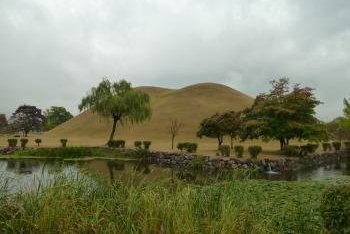
I found Gyongju to be a pleasant place to be based during my first few days in Korea. Some guidebooks seem to go over the top with their praise of the place which can leave people disappointed with the reality, however for me it was a great place to relax and see some of the most important sites in Korean history.
On the bus to the city I got a great introduction by listening to this episode, from the British Museum/ BBC A History of the World in 100 objects. On top of this I visited the free Gyonju museum which was very interesting although a touch over run with friendly school children practicing their English on me. These gave me a better understanding of what may otherwise just be a series of grassy hills. I have actually visited a fair few grass mounds in my pursuit of World Heritage Sites but these were the most enjoyable I have so far encountered. The central cluster are actually a very enjoyable piece of landscape design and are very well presented, also there is one tomb open for you to explore the interior, which is well worth a look.
There are two other WHS nearby and whilst the modern town is decidedly unremarkable, it has all the amenities you will need making this a great place to be based in the south of the country.
[Site 6: Experience 10*]
* A note to explain the top marks for the experience at …
Keep reading 0 comments
I have been doing an exchange program for one semester here as an archaeologist, and truly I can say: "Gyeongju is a treasure paradise to any archaeologist!"
As a student in Dongguk University's Archaeology Department, I have been able to get a good look at the current excavations being done, as well as seeing all the sites that are to be seen in and around Gyeongju. What history! There are so many stories yet to be told from this city as the excavations will be going on until 2025. We think we know it all, but no, no, there's so much yet to be learned about the lives lived in the historical era of Silla.
In my personal opinion, people who expect too much miss out the little things which truly makes Gyeongju the exciting historical site it is being advertised as. I can take a walk along the riverside, in the mountains or by the farm roads and find small pieces of artefacts all over. In walking at the edge of the wall of Banweolseong fortress I even stumbled across a near complete earthenware from around AD. 500!! (It has been, as required by law, given to the National Museum of Gyeongju.) When walking in Gyeongju, you are literally walking on historical grounds filled with artefacts from its days. It is such an amasing experience! ...well, at least for anyone with historical/archaeological interest who fare with an open mind.
It is absolutely a place worth while taking your time …
Keep reading 0 comments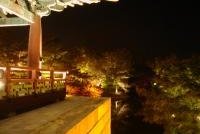
The legendary capital city of the sophisticated kingdom of Silla, the first great capital of unified ancient Korea, the fourth largest cultural, economic, and political center of known ancient world, one of the oldest human living cities in the world, an open-air museum are all the superlative definitions of Gyeongju stipulating all tourists to visit making this city one of the MUST destinations in Korea.
For sure all clarification above make you expected something great from Gyeongju with many ruins like ancient Greek or Roman cities. But Gyeongju turned out to be quite disappointing with nothing much to see, most of historical sites are burial mounds in the park, with few outstanding buildings. Cheonseomdae, the tiny ancient planetarium, and beautiful Anapji Pond are two major sights but are not so outstanding in my opinion. To flavor many bored tourists the city of Gyeongju tries their best to turn historical park into flower fields to make the park more attractive especially in the evening with the really nice set of light decoration. Another area that worth mentioned is Mount Namsan with lots of Buddhist artifacts scattered around the mountain but considering the quality of art, Seokguram Grotto is much superior.
Many tourists and reviewer praised Gyeongju by admiring Bulguksa Temple and Seokguram Grotto, but we should separate these two places from Gyeongju as they are different site in term of World Heritage. So, if we cut Bulguksa out from Gyeongju, I rarely heard people mentioned the beauty of …
Keep reading 0 comments
Some twenty years ago I lived in the city known as Taegu, better known today as "Daegu",city only about fourty minutes away from Gyeongju,city of ancient Shilla Kingdom. The Gyeongju city has more than thousand years of history,which by the way makes one of the oldest human living city in the world, and certainly makes older than any other western european cities except Athens and Rome as exception,and certaintly makes order than London city. Though today city is modern and only hold only some 350,000 thousand people,please do understand at one time in it's prime days,Gyeongju city was world's forth largest cultural,economical,and political center of known ancient world followed by Constantinople,Baghdad and Changan of China with population close to a million people,so you do a math. To those who did not enjoyed city of Gyeongju I feel sorry to heard that,but like anywhere else not every can have pleasent experince where ever you go,but word of advice,when you do travel to different cities of any nationalists,do little bit of research before you travel,and travel with open mind without any prejudices, than you will truly able to understand and appreciate more where ever you visits! Enjoy your travel!
Keep reading 0 comments
My father lived in Corea in 1985, for he was bilding a nuclear power plant in Uljin, and i spent 2,5 monthes there. We were living in the contry-side, in Buku, and i had time to integrate a bit of corean culture before going to Kyongju. I think it's necessary to understand what might be invisible to occidental eyes.
Being archeologist, i found great interrest in the site. The people who worked there did a real good job (excavation, and conservation)
Keep reading 0 comments
I am dissappointed with the negative responses seen here! As an English teacher travelling and living in Korea, I consider myself lucky to have had the opportunity to see the amazing historical treasure that is Gyeongju. Gyeongju has the amazing atmosphere of a lost Asian empire, and all the history you need to make the pieces fit can be found in the great museum. The burial mounds are fantastic and the town itself is a melting pot of different times.
Keep reading 0 comments
I had the pleasure of visiting Korea in 2003. I was not impressed with Seoul but when we went to Gyeongju, it was overwhelming. The temples are beautiful. The monks are very friendly and hospitable. You could feel the sacredness of Bulguska temple and the Seokguram Grotto.It seemed like time was at a stand still. It was a very healing experience for me and my family. We are planning on returning in 2005.
Keep reading 0 comments
Kyongju is very very overrated, I moved to the city almost 6-months ago, choosing a job there over one in Seoul because I had read about how beautiful it was meant to be. Quite frankly I am very disappointed.
The city of Kyongju is a hotchpotch of modern 1980's building which have been erected with absolutely no regulation or proper planning. In amongst this high rise hell are to be found a scattering of very unimpressive historical artifacts many of which would not be given a second glance were they to be found in Europe. OK the burial mounds are impressive, but they are not captivating in the way an old medieval town is.
Out with the city of Kyongju itself (it should be remembered that despite Kyongju being marketed as an open air museum some attractions are 20km away) things are much better. For example the temple at Bulguksa is absolutely fabulous as is Seokguram Grotto a short walk away.
Keep reading 0 comments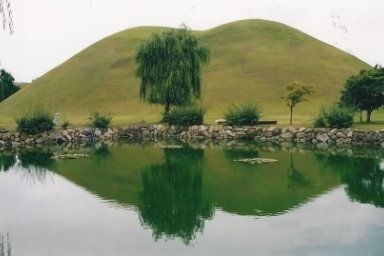
To be honest, I was a little bit disappointed by Kyongju (now spelled "Gyeongju" by the way). The historical relics are scattered around town, but most of them are not major sights. The cute Cheomsongdae Observatory is the one thing that you really must see here. So old, so delicate, and in such a good condition.
Keep reading 0 comments
